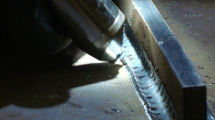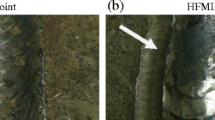Abstract
paper provides an overview of published experimental data on the fatigue strength of welded joints by high frequency mechanical impact (HFMI) treatment methods, In total, 414 data points from four specimen types are available,tests were performed using constant amplitude R = 0.1 axial tension fatigue, but some data for other R rations, variable amplitude testing and bending fatigue are also reported. An S-N slope of m = 5 gives a very good description of both individual data sets and of the composite data Design curve recommendations for the four joint types and for the structural stress-based design curve are given. HFMI treated specimens generally follow the same trend as experimental data for hammer peened specimens, but the degree of improvement is better. Data for large structures, at stress ratios other than R=0.1 and for variable amplitude loading are still needed in order to update the IIW guideline for post-weld improvement. There is a general trend for increasing fatigue strength improvement as a function of steel yield strength but this influence needs further study in order to develop guidelines. Quality assurance measures for HFMI treatment methods must also be defined.
Similar content being viewed by others
Abbreviations
- A:
-
Statistical intercept
- B:
-
Statistical slope
- Â:
-
Estimate of the intercept
- B:
-
Estimate of the slope
- Ci :
-
Fatigue capacity of specimen i
- C50% :
-
Computed mean fatigue capacity of test series
- C97.7% :
-
Characteristic fatigue capacity of the test serjes
- fy :
-
Yield strength
- fu :
-
Ultimate tensile strength
- FAT:
-
Characteristic fatigue class in MPa at 2 × 106 cycles to failure Characteristic fatigue class in MPa based on 97.7 % survival
- FAT97.7% :
-
probability at 2 × 106 cycles to failure at 75 % level of confidence
- k:
-
Number of test specimens in a data set
- kR :
-
Stress ratio correction factor
- khs :
-
Structural hot-spot stress concentration factor
- m:
-
Slope of the S-N curve
- N:
-
Number of fatigue cycles
- Nf :
-
Cycles to failure
- Ni :
-
The number of cycles to failure of specimen i
- Pf :
-
Probability of failure
- R:
-
Stress ratio
- ΔSi :
-
Stress range of specimen i
- Seq :
-
Equivalent constant amplitude stress range
- SnA5 :
-
Nominal stress amplitude at 5 % failure probabilities
- SnA95 :
-
Nominal stress amplitude at 95 % failure probabilities
- Tσ :
-
Scatter range in stress
- tp :
-
Student distribution
- Xi :
-
log Ni
- Yi :
-
log ΔSi
- \( \bar X \) :
-
Average of log Ni
- \( \bar Y \) :
-
Average of log ASi
- ŷ:
-
Estimate of log ASi
- σ:
-
Standard deviation
- \( \hat \sigma _{\rm N} \) :
-
Estimate of the normal distribution variance
References
Haagensen P.J. and Maddox S.J.: IIW Recommendations on post-weld fatigue life improvement of steel and aluminium structures, IIW Doc. XIII-2200r7-10, 2010.
Haagensen, P.: IIW’s round robin and design recommendations for improvement methods, in Proceedings of the IIW International Conference on Performance of Dynamically loaded welded structures., S.J. Maddox and M. Prager (eds), July 14–15, 1997, San Francisco, Welding Research Council, New York.
Hobbacher A.: IIW Recommendations for fatigue design of welded joints and components, Doc. IIW-1823, WRC Bulletin 520, The Welding Research Council, New York, 2009.
Maddox, S.J.: 2003 IIW Portevin lecture: Key developments in the fatigue design of welded constructions, Proceedings of the IIW International Conference, 10 July 2003, Welding in the World, 2003, vol 47, Special Issue, pp. 7–40.
Bignonnet A.: Improving the fatigue strength of welded steel structures, Steel in Marine Structures, Developments in Marine Technology, Proc. 3rd Intl ECSC Offshore Conference, C. Noordhoek, J. de Back (eds.), Elsevier Science Publishers, Delft, 15–18 June, 1987, pp. 99–118.
Ohta A., Watanabe O., Matsuoka K., Maeda Y., Suzuki N., Kubo T.: Fatigue strength improvement of box welds by low transformation temperature welding wire and PWHT., Doc. IIW-1480, Welding in the World, 2000, vol. 44, no. 3, pp. 52–56.
Barsoum Z. and Gustafsson M.: Fatigue of high strength steel joints welded with low temperature transformation consumables, Engineering Failure Analysis, 2009, vol. 16, no. 7, pp. 2186–2194.
Statnikov E., Trufyakov V.I., Mikheev P.P., Kudryavtsev Yu.F.: Specification for weld toe improvement by ultrasonic impact treatment, Doc. IIW-1346, Welding in the World, 2000, vol. 44, no. 1, pp. 5–7.
Applied Ultrasonics, In: http://www.appliedultrasonics.com/.
Integrity Testing Laboratory Inc, In: http://itlinc.com/.
Lets Global, In: http://www.lets-global.com/.
Zhao X., Wang D. and Huo L.: Analysis of the S-N curves of welded joints enhanced by ultrasonic peening treatment., Materials and Design, 2011, vol. 32, no. 1, pp. 88–96.
Pfeifer, In: http://www.pfeifer.de/.
Pitec, In: http://www.pitec-gmbh.com/
Sonats, In: http://www.sonats-et.com/.
Bousseau M. and Millot T.: Fatigue life improvement of welded structures by ultrasonic needle peening compared to TIG dressing, IIW Doc. XIII-2125-06, 2006.
Haagensen P.J. and Alnes Ø.: Progress report on IIW WG2 round robin fatigue testing program on 700 MPa and 350 MPa YS Steels, IIW Doc. XII I-2081-05, 2005.
Weich, I.: Ermüdungsverhalten mechanisch nachbehandelter Schweißverbindungen in Abhängigkeit des Randschichtzustands, Fatigue behaviour of mechanical post weld treated welds depending on the edge layer condition, Technischen Universität Carolo-Wilhelmina, Doctorate Thesis, 2008 (in German).
Huo L., Wang D. and Zhang Y.: Investigation of the fatigue behaviour of the welded joints treated by TIG dressing and ultrasonic peening under variable-amplitude load. International Journal of Fatigue, 2005, vol. 27, no. 1, pp. 95–101.
Martinez L., Blom A.F., Trogen H. and Dahle T.: Fatigue behavior of steels with strength levels between 350 MPa and 900 MPa influence of post weld treatment under spectrum loading, In Blom A., ed.: Proceedings of the North European Engineering and Science Conference (NESCO): Welded High-Strength Steel Structure, Stockholm, 1997.
Wang T., Wang D., Huo L. and Zhang Y.: Discussion on fatigue design of welded joints enhanced by ultrasonic peening treatment (UPT), International Journal of Fatigue, 2009, vol. 31, no. 4, pp. 644–650.
Lihavainen V.M., Marquis G., Statnikov E.S.: Fatigue strength of a longitudinal attachment improved by ultrasonic impact treatment, Doc. IIW-1631, Welding in the World, 2004, vol. 48, no. 5/6, pp. 67–73.
Maddox S.J., Dore M.J. and Smith S.D.: A case study of the use of ultrasonic peening for upgrading a welded steel structure, Doc. IIW-2203, Welding in the World, 2011, vol. 55, no. 9/10, pp. 56–67.
Marquis G. and Björk T.: Variable amplitude fatigue strength of improved HSS welds, IIW Doc. XIII-2224-08, 2008.
Mori T., Shimanuki H. and Tanaka M.: Effect of UIT on fatigue strength of web-gusset welded joints considering service condition of steel structures, Doc. IIW-2318, to be published in Welding in the World, 2012, vol. 56, no. 9/10.
Leitner M., Stoschka M., Schörghuber M. and Eichlseder W.: Fatigue behaviour of high-strength steels using an optimized welding process and high frequency peening technology, Proceedings of the IIW International Conference, Chennai, 21–22 July, 2011, IC38.
SSAB: Domex 420 MC D Hot rolled, high strength, cold forming steel, DATASHEET: 11-02-03 GB8415 DOMEX.
SSAB: Domex 700 MC Hot rolled, extra high strength, cold forming steel, DATA SHEET: 11-02-03 GB8421 DOMEX.
SSAB: Domex 960 Structural strip steel sheet, DATA SHEET: 11-02-16 GB8435 DOMEX.
Trufiakov V.I., Statnikov E.S., Mikheev P.P. and Kuzmenko A.Z.: The efficiency of ultrasonic impact treatment for improving the fatigue strength, IIW Doc. XIII-1745-98,1998.
Pedersen M., Mouritsen O.Ø., Hansen M.R., Andersen J.G. and Wenderby J.: Comparison of post-weld treatment of high-strength steel welded joints in medium cycle fatigue, Doc. IIW-2077, Welding in the World, 2010, vol. 54, no. 7/8, pp. R208–R217.
Galtier A. and Statnikov E.: The influence of ultrasonic impact treatment on fatigue behaviour of welded joints in high-strength steel, IIW Doc. XIII-1976-03, 2003.
Statnikov E.S., Muktepavel V.O. and Blomqvist A.: Comparison of ultrasonic impact treatment (UIT) and other fatigue life improvement methods, doc. IIW-1506, Welding in the World, 2002, vol. 46, no. 3/4, pp. 20–32.
Kuhlmann U., Dürr A., Bergmann J. and Thumser R.: Effizienter Stahlbau aus höherfesten Stählen unter Ermüdungsbeanspruchung, Fatigue strength improvement forweldedhighstrengthsteelconnectionsduetotheapplication of post-weld treatment methods, Forschungsvorhaben P620 FOSTA, Verlag und Vertriebsgesellschaft GmbH, Düsseldorf, 2006 (in German).
Kudryavtsev Y., Kleiman J., Lugovskoy A., Lobanov L., Knysh V., Voitenko O. and Propenko G.: Rehabilitation and repair of welded elements and structures by ultrasonic peening, Doc. IIW-1806, Welding in the World, 2007, vol. 51, no. 7/8, pp. 47–53.
Kuhlmann U. and Gunther H.: Experimentelle Untersuchungen zur ermüdungssteigernden Wirkung des PIT-Verfahrens, Experimental investigations of the fatigue-enhancing effect of the PIT process, Versuchsbericht, Universität Stuttgart, Institut für Konstruktion und Entwurf, September 2009 (in German).
Okawa T., Shimanuki H., Funatsu Y., Nose T. and Sumi Y.: Effect of preload and stress ratio on fatigue strength of welded joints improved by ultrasonic impact treatment., IIW Doc. XII I-2377-11,2011.
Janosch J.J., Koneczny H., Debiez S., Statnikov E.C., Troufiakov V.J. and Mikhee RR: Improvement of fatigue strength in welded joints (in HSS and in aluminium alloys) by ultrasonic hammer peening, Doc. IIW-1300, Welding in the World, 1996, vol. 37, no. 2, pp. 72–82.
Fricke, W.: IIW Recommendations for the fatigue assessment by notch stress analysis for welded structures, IIW Doc. XIII-2240r3-10, 2010.
ASTM E739-10: Standard Practice for Statistical Analysis of Linear or Linearized Stress-Life and Strain-Life Fatigue Data, 2010.
Marquis G.: Failure modes and fatigue strength of improved HSS welds, Engineering Fracture Mechanics, 2010, vol. 77, no.11, pp. 2051–2062.
Maddox S.J.: Progress report on IIW Working Group 2 round robin fatigue testing programme, IIW Doc. XIII-WG2-104-04, 2004.
Gurney T.: Effect of peening and grinding on the fatigue strength of fillet welded joints, British Welding Journal, December 1968, pp. 601-609.
Branco, C., Infante, V. and Baptista, R.: Fatigue behaviour of welded joints with cracks, repaired by hammer peening, Fatigue & Fracture of Engineering Materials & Structures, 2004, vol. 27, no. 9, pp. 785–798.
Manteghi S. and Maddox S.J.: Methods for fatigue life improvement of welded joints in medium and high strength steels, IIW Doc. XIII-2006-04, 2004.
Booth G.: Techniques for improving the fatigue strength of plate welded joints, Steel in Marine Structures, SIMS-87, Paper TS 41, 1987, pp. 747-757.
Author information
Authors and Affiliations
Corresponding author
Rights and permissions
About this article
Cite this article
Yildirim, H.C., Marquis, G.B. Overview of Fatigue Data for High Frequency Mechanical Impact Treated Welded Joints. Weld World 56, 82–96 (2012). https://doi.org/10.1007/BF03321368
Published:
Issue Date:
DOI: https://doi.org/10.1007/BF03321368




